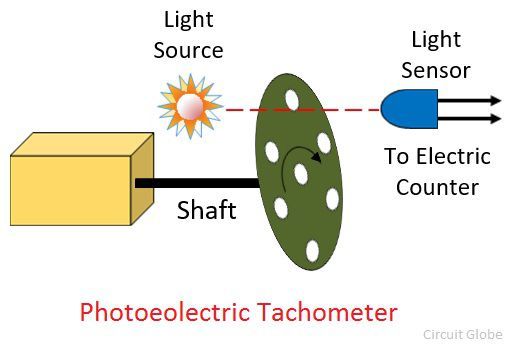Photoelectric Tachometer
Definition: A photoelectric tachometer is a device that measures the rotational speed of a machine's shaft or disc by utilizing light. Its essential components include an opaque disc with holes along its periphery, a light source, and a light - sensing element (it should be noted that the original text's mention of "laser" might be a misnomer; typically, a photodetector is used. A laser could be a part of some more complex set - ups, but not in a basic photoelectric tachometer configuration). The light source emits light, which passes through the holes in the rotating opaque disc and is detected by the light - sensing element, enabling the determination of the rotational speed.
The tachometer features an opaque disc that is mounted on the shaft whose rotational speed is to be measured. The disc has evenly - spaced holes around its periphery. A light source is positioned on one side of the disc, and a light sensor is placed on the opposite side, with both being precisely aligned with each other.
As the disc rotates, its holes and opaque sections alternately pass between the light source and the light sensor. When a hole aligns with the light source and the light sensor, light passes through the hole and reaches the sensor. This causes a pulse to be generated. These pulses are then measured using an electric counter.

When the opaque portion of the disc aligns with the light source and the sensor, the disc blocks the light from the source, and the sensor output drops to zero. The generation of pulses is determined by two main factors:
The number of holes on the disc.
The rotational speed of the disc.
Since the number of holes is fixed, pulse generation is primarily dependent on the disc's rotational speed. An electronic counter is employed to measure the pulse rate.
Advantages of Photoelectric Tachometer
It provides a digital output voltage, eliminating the need for analogue - to - digital conversion.
The pulses produced have a constant amplitude, which simplifies the associated electronic circuitry.
Disadvantages of Photoelectric Tachometer
The lifespan of the light source is around 50,000 hours. As a result, the light source must be replaced at regular intervals.
The accuracy of this measurement method is affected by errors associated with individual unit pulses. These errors can be mitigated by using a gating period. The gating period refers to the process where the meter measures the frequency by counting the input pulses over a specific time interval.
Minimizing errors can also be achieved by considering the total number of pulses generated per revolution.
The Electricity Encyclopedia is dedicated to accelerating the dissemination and application of electricity knowledge and adding impetus to the development and innovation of the electricity industry.













